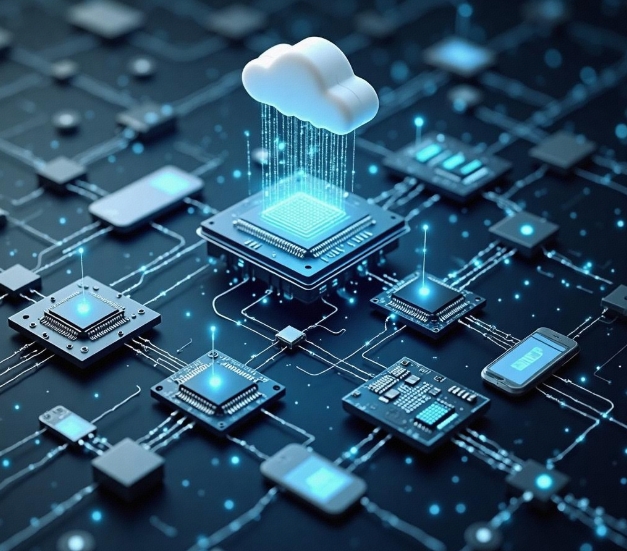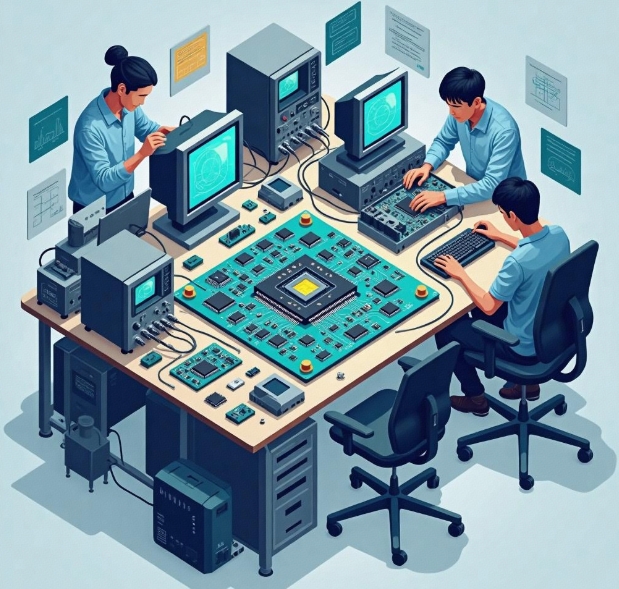IoT Development Process: Complete Steps from Requirements to Product
- latest articles
- 1.DApp Development & Customization: Merging Diverse Market Needs with User Experience 2.Analysis of the Core Technical System in DApp Project Development 3.How to achieve cross-chain interoperability in Web3 projects? 4.How does the tokenization of points reconstruct the e-commerce ecosystem? 5.How to Set and Track Data Metrics for a Points Mall? 6.What is DApp Development? Core Concepts and Technical Analysis 7.Inventory of commonly used Web3 development tools and usage tips 8.Development of a Distribution System Integrated with Social E-commerce 9.Six Key Steps for Businesses to Build a Points Mall System 10.What is DApp Development? A Comprehensive Guide from Concept to Implementation
- Popular Articles
- 1.Future Trends and Technology Predictions for APP Development in 2025 2.Analysis of the DeFi Ecosystem: How Developers Can Participate in Decentralized Finance Innovation 3.From Zero to One: How PI Mall Revolutionizes the Traditional E-commerce Model 4.DAPP Development | Best Practices for Professional Customization and Rapid Launch 5.How to Develop a Successful Douyin Mini Program: Technical Architecture and Best Practices 6.Recommended by the Web3 developer community: the most noteworthy forums and resources 7.From Cloud Computing to Computing Power Leasing: Building a Flexible and Scalable Computing Resource Platform 8.Shared Bike System APP: The Convenient Choice in the Era of Smart Travel 9.How to Create a Successful Dating App: From Needs Analysis to User Experience Design 10.From Design to Development: The Complete Process of Bringing an APP Idea to Life
With the advancement of technology, the Internet of Things (IoT) has gradually permeated various industries, from smart homes and health monitoring to industrial automation, with increasingly widespread application scenarios. However, transforming the concept of IoT into practical, usable products and successfully deploying them into the market requires a series of complex and precise steps. This article details the complete process of IoT product development, from requirements analysis to product realization, helping developers and enterprises understand how to efficiently design, develop, and deploy IoT solutions.
I. Requirements Analysis and Market Research
The first step in IoT development is always requirements analysis and market research. The goal of this phase is to clearly understand the needs of the target users, identify technically feasible solutions, and define the product's functions, performance indicators, and market positioning.
Define Requirements: Determine the core functions of the IoT application. For example, if developing a smart home device, the requirements analysis should consider whether users need features like smart lighting control, temperature adjustment, or security monitoring.
User Research: Use methods such as surveys and user interviews to gather specific needs and pain points of the target users. This step is fundamental to ensuring the product meets market demands.
Market Competition Analysis: Study similar products in the existing market, evaluate their strengths and weaknesses, and identify the competitive advantages of your own product.
Technical Research: Determine the technical details required to meet the needs, such as hardware devices, sensors, and communication protocols. For example, choosing between Bluetooth, Wi-Fi, or 5G for data transmission.
After this phase, the development team typically produces a detailed requirements document, which serves as the blueprint for subsequent development.
II. Product Design
Once requirements are clear, the next step is the product design phase, which involves the system architecture design, hardware selection, and software development plan for the IoT product.
System Architecture Design: Design the overall architecture of the product, including the device, cloud, and user-end systems. Consider how devices interact with the cloud, how the cloud stores and processes data, and how users control the devices via terminals like phones and computers.
Hardware Design and Selection: In hardware design, select appropriate sensors, chips, MCUs (Microcontroller Units), communication modules, etc. For instance, developing a smart temperature control device requires selecting suitable temperature and humidity sensors and appropriate communication protocols.
Communication Protocol Selection: Choose the appropriate communication protocol based on the IoT product's application scenario, such as LoRa, Zigbee, Wi-Fi, NB-IoT, etc. Factors like transmission distance, battery consumption, and transmission speed need to be considered during selection.
Software Architecture Design: Design the software architecture based on product requirements, including device firmware, cloud applications, and user-end app design. Software design must focus on the security, real-time performance, and stability of data transmission.
III. Hardware Development and Prototyping
Hardware development is a critical step in IoT product development. In this phase, the development team selects, procures, and integrates hardware based on design and requirements documents.
Hardware Prototyping: Select suitable prototyping boards, such as Raspberry Pi or Arduino, to quickly create initial prototypes. Prototype testing allows early validation of whether the hardware design meets expected requirements, avoiding risks before mass production.
Circuit Design and Debugging: Circuit board design must consider the interconnection of components like sensors, microprocessors, and communication modules to ensure proper electrical design and signal processing.
Hardware Testing: Conduct various functional and performance tests on the hardware, such as signal transmission tests and battery life tests.
PCB Design and Production: After the hardware prototype is verified, proceed with PCB (Printed Circuit Board) design to finalize the hardware design before mass production.
IV. Software Development and System Integration
Building on the hardware, IoT product development relies on software support. Software development is typically divided into the following parts:
Device Firmware Development: Device firmware acts as the bridge between IoT devices, the cloud, sensors, and communication modules. Firmware development must ensure stable data collection and transmission, with high efficiency and low power consumption.
Cloud Platform Development: The cloud platform is responsible for receiving, storing, analyzing, and processing data from devices. Common cloud platforms include AWS IoT, Microsoft Azure IoT, and Alibaba Cloud IoT. During cloud development, special attention must be paid to data security and privacy protection, ensuring compliance with industry regulations.
User-End App Development: To allow users to conveniently control IoT devices, the development team needs to design and implement mobile applications that connect to the IoT devices. These apps typically need to support remote control, status monitoring, data display, and other functions.
System Integration and Testing: After both hardware and software are developed, perform system integration to ensure seamless connection between devices, the cloud, and the user end. Conduct stress tests, load tests, etc., to ensure system efficiency and stability.
V. Testing and Quality Control
In IoT product development, the testing and quality control phase is crucial. Only through multiple rounds of rigorous testing can the product's stable operation be guaranteed, avoiding unnecessary failures on the user end.
Hardware Testing: Includes electrical safety, environmental adaptability tests (such as high temperature, humidity, vibration tests), functional tests, and performance tests.
Software Testing: Includes unit testing, integration testing, stress testing, security testing, etc., to ensure software stability and security.
System Testing: After all hardware and software development is complete, conduct system-level testing to ensure all parts work together.
User Experience Testing: Before the final product release, conduct user experience testing, collect feedback, and optimize the product accordingly.
VI. Mass Production and Market Promotion
After the initial R&D and testing, the IoT product finally enters the mass production stage. This phase requires ensuring production line stability and product quality consistency.
Production Line Preparation: Ensure the production process is efficient and stable, with strict quality control to avoid batch defects.
Packaging and Shipping: Package the IoT devices and prepare for shipping. Usually, relevant user manuals, installation guides, and other materials are also provided.
Market Promotion and Sales: Develop marketing strategies, promote the product through advertising, social media, and other channels to attract the target user group.
After-Sales Service and Support: Provide comprehensive after-sales service and technical support to ensure user experience and long-term product stability.
VII. Conclusion
IoT development is not merely a technical implementation process; it also requires consideration of market demands, technical feasibility, user experience, and other aspects. From requirements analysis to product realization, every stage of IoT development is crucial. Only through meticulous design, development, and testing can a market-ready IoT product be successfully launched.
As IoT technology continues to advance, future IoT products will become smarter, more efficient, and possess greater adaptability and universality. For developers, keeping up with technological trends, mastering relevant skills, and paying attention to details during development are key to ensuring product success.
-

How to Use IoT Development to Enhance Supply Chain Efficiency
With the rapid development of the global economy and the deepening of digital tr···
-

Development and Innovation of the Internet of Things in the Healthcare Sector
With the rapid advancement of information technology, the Internet of Things (Io···
-

Data Storage and Analysis Methods in IoT Development
The Internet of Things (IoT) is one of the most revolutionary innovations in tod···

 Blockchain
Blockchain












